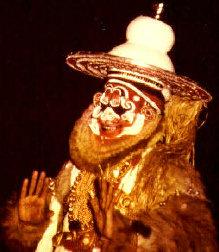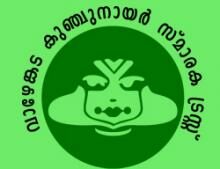A master who was not paid his due
Prof.(Rtd.) C.P. Unnikrishnan
July 28, 2012

The few lines I write are just few reflections and my personal feelings and thoughts about a great Kathakali vesham artist ie. Kumarnaasaan; and is just an exposition of my aesthetic sensibility of which there is no claim of any standard.
Incidentally, Kumaranaasaan happens to be one of my noteworthy memorable very distant relatives. Hailing from Vellinezhi which happens to be the ‘birth-home’ of several stalwarts, aassan did not have the recognition that was due for his human nature, mastery over technical skills and aesthetic sensitivity and sensibility. The question why he had to leave Kerala in his robust days and migrate to the tinsel and ‘the other dance world’ remains a mystery to me; perhaps many others too; if plagiarism, favouritism and various types of biases are kept apart. Speaking the greatness of and celebrating and cherishing the bygone glories are embedded in human culture as a happy post-mortem ritual; may be inevitable.
If many of the living maestros are applauded and praised for what they were and are now, I should honestly record that the same was not done to Kumaranaasaan. What did he lack to bear such a denial? I have had blessed opportunities to be on the stage with him few times and witness his portrayal of Vellathaadi, Kathi, Pacha, Kaattalan and Minukku several times. Elizabeth, a foreign researcher during a personal discussion among herself, Kottakkal Nanadakumaran Nair and myself said: “Time is after Ramankutty aasaan and he is not after time.” Absolutely, true.
A clean unbiased analysis of Kumaran Nair’s performances did bear testimony to his abidance by the stipulated norms of the body kinetics of Kathakali veshams. He had the psyche and the physique, each one in their apt proportions, favourably tailor-made by nature to befit the demands of his professional deliberation. I would not hesitate to say that ‘Time and space were after him’.
Kumaaranaasan meticulously dovetailed his passion to precision well within the ambits of the permitted nuances. Few of the comments, unfortunately even from the artists and connoisseurs included his tendency to slip into ‘dance’. Personally I beg to differ. In the concepts of aesthetics an artist has the freedom to find (rather than create) pleasing blends of dynamic visual sculptures. Has not the body language of Kathakali imbibed and absorbed kinetics from many other ritual and performing arts? Plenty of such immigrations can be listed. But, even when aasaan intertwined kinetic techniques he did absolute justice to Kathakali veshams. Most relevant factor to be underlined and constantly remembered is that the performance of vesham is a dynamic process. He had the wisdom to realise and demonstrate that holistic endeavour, which may be nearly translated as ‘Sarvvanga-abhinaya’ and not facial expressions and gestures is the conspicuous feature of Kathakali.
Kumaranaasaan was intelligent, analytical, artistic and positively shrewd. He asked several thought provoking questions. Most of them were known to all, but at the moment of his questioning even experts temporarily failed to recognise the answer. He asks: Which sequence in the totality of Kathakali can one find all the taalas being used? In which story does a Taadi vesham slays a Pachavesham? Who is ‘mrudngasaila nilaya’? Of course, now these have become popular and many would respond correctly. But, they were tough when they were asked first. Rather than trying to interpret such tendencies as his intentional attempts to show off, they must be accepted as his pointers towards the need to delve deeper into ones own professionalism and its allied aspects.
I am no one to comment on his Kathakali-character-wise technical efficiencies. Kumaran aasaan and those who had the chance to be under his tutelage did and do bear a distinct mark. My humble belief is they should be justified as well defined contributions to Kathakali. Asaan, consciously believed in preservation and transfer which is possible only through transformation. In the process the aesthetic and structural ideals were not compromised to the extent of distorting the art, unduly mystifying, or destroying it. And, is it not the prime duty of and the commitment expected from a cultural-ambassadoor ?!
